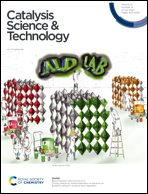Impact of unintentionally formed CH2O in oxygenated fuel exhausts on DeNOx-SCR at different NO2/NOx ratios under close to real conditions†
Abstract
This study investigates for the first time the influence of the NO2/NOx ratio on formaldehyde-related effects under close to real conditions using a copper exchanged chabazite type zeolite (Cu-CHA) series production catalyst. This study demonstrates that under the chosen reaction conditions, formaldehyde reacts preferentially with NH3 to form a yet to be determined intermediate, which subsequently leads either to its catalytic decomposition without the formation of hazardous pollutants, or to thermal decomposition with the release of toxic HCN, depending on the NO2/NOx ratio. Especially at small NO2/NOx fractions, not only toxic products are formed, but also NOx conversion efficiency is drastically deteriorated. In contrast, at high NO2 fractions, the presence of formaldehyde prevents the formation of ammonium nitrate on the catalyst surface and thus prevents the release of N2O, leading to a strong improvement in NOx conversion efficiency compared to studies without formaldehyde.



 Please wait while we load your content...
Please wait while we load your content...